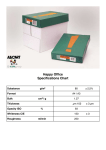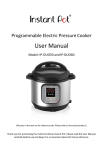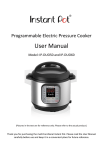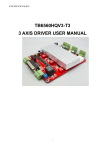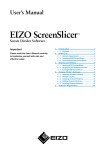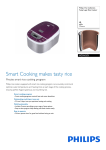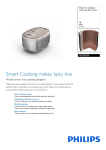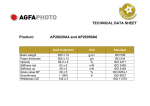Download C-600 Manual E Rev0201
Transcript
Rice Whiteness Tester C-600 User Manual Safety Precautions If this device is not used according to safety precautions, accidents can occur which may cause damage to the instrument, the operator or other items. Our design has included substantial consideration for product safety but please read the precautions contained in this user manual and use the product correctly. ■ Please obey all safety precautions Please thoroughly read the precautions included in the user manual. ■ Please don't use this product if it is not working properly If the product should break or malfunction, please contact the retail outlet where you purchased the product or our company directly. ■ Interpreting warning symbols The following symbol is displayed in this user manual to help prevent an incident from occurring due to inappropriate use of this device. Caution This symbol is displayed along with instructions that, if ignored, and if the device is inappropriately used, may lead to the user suffering an injury or material damage. Table of Contents 1. Measurement Principles and Characteristics...................................... 4 2. Specifications......................................................................................... 5 3. Part Names.............................................................................................. 6 4. Description of Operation Keys.............................................................. 7 5. Preparing for Measurement................................................................... 8 6.Measurement.......................................................................................... 9 7. Maintenance and Other Functions.......................................................11 8.Errors.......................................................................................................14 1. Measurement Principles and Characteristics ■ Measurement Principles This device is designed to measure the whiteness of rice based on our own uniquely developed standard. The C-600 measures reflectivity and utilizes two blue LEDs as its light source. The light from the blue LEDs shine onto the sample surface at a 45 degree angle. Next, the amount of reflected light reflected is measured with a photo diode. The whiter the sample, the more light reflected back and detected, and thus a higher measurement value is registered. The whiteness of rice correlates directly with the milling percentage of that rice. Therefore, you can use this device to indirectly measure the milling percentage of a rice sample. ■ Characteristics This device is lighter and more compact than our previous C-300 model. Furthermore, using blue LED light sources allows for a longer light source lifetime, reduced power consumption and reduced heat generation. Sensitivity calibration when the device is turned on has also been reduced, allowing you to begin measurements faster when compared to previous models. 4 2. Specifications Measurement Method : Reflectivity measurement Accepted Samples :Non-glutinous polished rice, non-glutinous brown rice, non-glutinous prewashed rice, glutinous polished rice, glutinous brown rice, glutinous prewashed rice Measured Item : Whiteness Measurement Range : 5.0 to 69.9 Resolution :0.1 Display Method : Fluorescent display tube Functions : Average, printer output Usable Temperature/Humidity Range :Temperature: 5 to 40°C, Humidity: 30 to 85% (non-condensing) Light Source : Blue LED External Output : RS-232C Power Source : AC 100V-120V (50/60Hz) : Power cord A (Flat blade attachment plug, Type A-1) AC 200V-240V (50/60Hz) : Power cord B (Round pin attachment plug, Type C-4) Maximum Power Consumption : 35 W (100 V), 60 W (240 V) Dimensions : 290 (W) × 295 (D) ×185 (H) mm Weight : 5.0 kg Included Parts :Whiteness standard plate, sample case, sample platter, fixed quantity shooter, sample cup, main unit cover, glass wipe, replacement sponge, replacement packing (x3), replacement fuse, power cord A (100-120V) or power cord B (200-240V) , power plug adapter, user manual Optional Items : Printer VZ-330, printer connector cable VZC-14 5 3. Part Names <Main Unit> <Front Side> <Rear Side> Display Sample Case Slot Power Switch Power Connector Front Cover Fuse Holder RS-232C Connector Glass Filter Exhaust Key <Included Parts - with part numbers> Whiteness Standard Plate C-600-01 Sample Case C-600-02 Sample Platter C-600-03 Fixed Quantity Shooter C-600-04 Main Unit Cover C-600-06 Glass Wipe C-600-07 Replacement Sponge C-600-08 Replacement Packing (x3) C-600-09 Sample Cup C-600-05 Replacement Fuse C-600-10 <Optional Parts> A or B ower Cord A P (100V-120V) C-600-11-A Power Cord B Power Plug Conversion Adapter User Manual (200V-240V)C-600-12C-600-13 C-600-11-B attached for Power cord A (It(foris 100V-120V uses) only. ) 6 Printer VZ-330 Printer Connector Cable VZC-14 C-600-14 C-600-15 4. Description of Operation Keys <Operation Panel> Key Function Used to turn the printer output ON or OFF. Used as a backspace when inputting numerical values. Used to input standard plate values. Used to finalize numerical input. ~ Used to input numerical values. Used for sensitivity calibration. Used to display the average of the measured values. 7 5. Preparing for Measurement 5-1. Connecting the Power Cord [Caution]P ower supply voltage may be different when using this product in other countries. Please only use a power cord designed for your country. (1) Insert the power cord into the power supply connector on the rear side of the main unit. (2) If the power supply is a three-prong plug 100V-120V outlet, insert the power cord into VAC outlet. (See the right fig and in case of 100V-120V uses with blade plug condition) Connect the included power plug conversion adapter into the power cord first, then plug the cord into a 100V-120V power outlet. Next, connect the ground wire on the power cord to the ground. [Caution]200V-240V outlet is used, power cord B should be used. [Caution] If the power supply is 200V-240V with flat blade plug, the conversion adapter should be prepared by yourself. 5-2. Inserting the Whiteness Standard Plate As shown in the figure, insert the whiteness standard plate into the sample case slot on the main unit until it cannot be inserted any further. [Caution]The whiteness standard plate lid should never be opened unless you need to clean the glass surface. [Caution]Make sure the rice whiteness plate is facing in the correct direction. 5-3. Starting Up the Main Unit Turn the power switch located on the rear side of the main unit to ON. "WARMING-UP" is displayed. You will see numbers flashing and after approximately 20 seconds, the value of the whiteness standard plate is displayed. Once the value of the whiteness standard plate is displayed, remove the whiteness standard plate. [Caution]If the whiteness standard plate is not inserted correctly when the power switch is turned ON, the display will repeatedly show "INSERT STD. "If this should occur, insert the whiteness standard plate into the sample case slot on the main unit until it cannot be inserted any further. Rear Side [Caution]If the power supply is 100V-120V with round pin plug, the conversion adapter should be prepared by yourself. Whiteness Standard Plate The C-600 is now ready for measurement. 8 Sample Case Slot 6. Measurement [Caution]Before performing any measurements, use the glass wipe to clean the glass surface of the sample case and the main unit's glass filter. 6-1. Inserting the Sample for Testing Fixed Quantity Shooter (1) Place the sample case on a flat surface and set the sample platter. Sample Platter Sample Case (2) Place the fixed quantity shooter on the sample platter. (3) Put a level cup of rice in the sample cup, then pour the rice from the cup through the hole in the fixed quantity shooter. Insert all of the rice from the cup until the rice begins to overflow out of the hole in the fixed quantity shooter. [Caution]T he sample cup is designed for acquiring a sample of rice only. Do not use the sample cup as a container for any other purpose. (4) Remove the fixed quantity shooter from the sample platter and tightly close the lid on the sample case. [Note]By carefully following the above instructions you can virtually eliminate any discrepancies in measurement values due to human error. If you do not properly insert the test sample, you will not receive an accurate measurement. 9 Fixed Quantity Shooter Hole 6-2. Insertion Into the Main Unit Insert the sample case into the sample case slot on the Rear Side Sample Case main unit until it cannot be inserted any further. [Caution]M ake sure the sample case is facing the correct direction. 6-3.Measurement Once the sample case has been inserted into the main unit, the number of times measured and the whiteness value are displayed on the display. ■ Average Value You can also display the average value of two to nine measurements. After performing between two to nine key to view the average measurements, press the value and the number of times measured. Once the average value is displayed, all values up to that point are cleared and the next measurement is treated as the first measurement of a new set. The number of measurements is displayed after each measurement is completed. However, the number of measurements is reset to one in the following cases. key is pressed. (1) When the (2) When the number of measurements exceeds nine. 6-4. Sensitivity Calibration After performing measurements for a long period of time, the sensitivity of the device may need to be re-calibrated. Therefore, you must check the sensitivity of the device from time to time. To check the sensitivity, insert the whiteness standard plate into the main unit and measure the value of the whiteness standard plate. If this measurement value is not equal to the number on the whiteness standard plate, the sensitivity needs to be rekey with the whiteness standard plate calibrated. Press the still inserted to automatically calibrate the sensitivity. key to calibrate the sensitivity You can also press the when "STD" is displayed in the upper-left corner of the display. 10 Sample Case Slot 7. Maintenance and Other Functions 7-1. Main Unit Glass Filter Handle If the glass filter on the main unit is dirty, you will not receive an accurate measurement. You must keep the glass filter Front Cover clean at all times when using the device. Use your finger to lift upwards on the handle on the inside of the front cover, in order to remove the front cover. This gives you access to the glass filter for cleaning. [Caution]There are sharp edges protruding from the front cover and the metal parts of the main unit. Be careCaution ful not to injure yourself when cleaning the glass filter. Glass Filter 7-2. Sample Platter Sponge As the sample platter sponge wears, the amount of sample material you can fit into the sample platter increases, which results in inaccurate measurements. The sponge needs Sponge to be replaced when you can see lines on the inside of the sample platter when it is empty. The sponge is attached to the bottom of the platter with double-sided tape. Simply pull out the sponge to replace it. 7-3. Main Unit Glass Filter Packing When the packing attached to the main unit's glass filter wears down, please replace it. If this packing wears down, a space will form between the glass filter and the sample case. [Caution] Attach the packing in the orientation shown in the figure. Worn Packing Wide Narrow 11 7-4. Inputting a Whiteness Standard Value (1) If the device is turned ON, turn the device OFF. (2) Insert the whiteness standard plate into the main unit. (3) When you turn the power switch ON, "WARMING-UP" is displayed. (4) After a few moments, the light on the lower right side will key. begin to flash. When this happens, press the (5) "INPUT STD" is displayed. (6) Input the three-digit number written on the whiteness standard plate. Press the key. [Note]If you make a mistake when inputting the number, you can press the your mistake. key to go back and correct [Note]You can only enter values in the range of 80.0 to 99.9. (7) "WARMING-UP" is displayed, and after a few moments, the value of the whiteness standard plate is displayed. Once the value of the whiteness standard plate is displayed, remove the whiteness standard plate. [Note]This procedure must be performed whenever the whiteness standard plate is replaced. 7-5. Replacing the Fuse (1) Turn the power OFF and disconnect the power cord from the power supply connector. (2) The fuse compartment is on the rear side of the main unit. Insert a flat head screwdriver or some other thin, flat object at the top of the fuse compartment and pull it out towards you. (3) Remove the fuse from the fuse compartment and check to see if it has been blown. (4) If the fuse is not blown, put it back into the fuse compartment. If the fuse is blown, replace it with the spare fuse or another compliant fuse (250 V, 3.15 A). (5) Insert the fuse compartment back into the main unit as it was before removal. (6) Insert the power cord back into the power supply connector of the device. [Note]If the fuse blows again after replacement, the device itself may be broken. If this should occur, please request a maintenance inspection. 12 7-6. Output to a Printer (Optional) You can output measurement data if you connect the device to an optional printer. Press this key to switch printer output ON or OFF. When the key is pressed and "PRINT" is displayed, printer output is turned ON. When "NO PRINT" is displayed, printer output is turned OFF. [Caution]Connect the device to the printer using the printer cable (VZC-14) only after setting up the printer (VZ-330). [Caution]Refer to the printer's user manual for more details about how to connect the device to the printer. [Caution]Whiteness values outside the range of 5.0 to 69.9 cannot be output. 13 [Printout Example] RICE WHITENESS TESTER C-600 TIMES 1 39.6 2 39.5 3 39.7 4 39.6 5 39.6 AVERAGE 39.6 8. Errors When an error occurs with this device, an error number is displayed alongside an error message. Display Cause Solution Circuitry error. Repair is required. No whiteness standard plate has Inser t the whiteness standard been inserted when attempting to plate, then tr y per forming the perform a sensitivity calibration. sensitivity calibration again. Circuitry error. Repair is required. Circuitry error. Repair is required. Circuitry error. Repair is required. Circuitry error. Repair is required. The value of the whiteness Follow the instructions for inputting standard plate is not the same as the whiteness standard value the value input on the main unit. (see Section 7-4) and try again. Circuitry error. 14 Repair is required. Notes ● Copying some or all of the contents of this user manual without prior written consent is strictly prohibited. ● The contents of this user manual may be changed at any time in the future without any prior notice. ● The appearance and/or representations of the products and parts depicted in this user manual may not appear exactly as their actual counterparts, but this does not affect their operation or functionality. ● This user manual was intended to be written as clearly and accurately as possible. However, if you are unclear about anything in this user manual or notice any missing information, please contact us directly. ● We cannot be held responsible for any actions or effects resulting from the execution of any operations outlined in this user manual. 1201 · PA · 0201 · 200
















